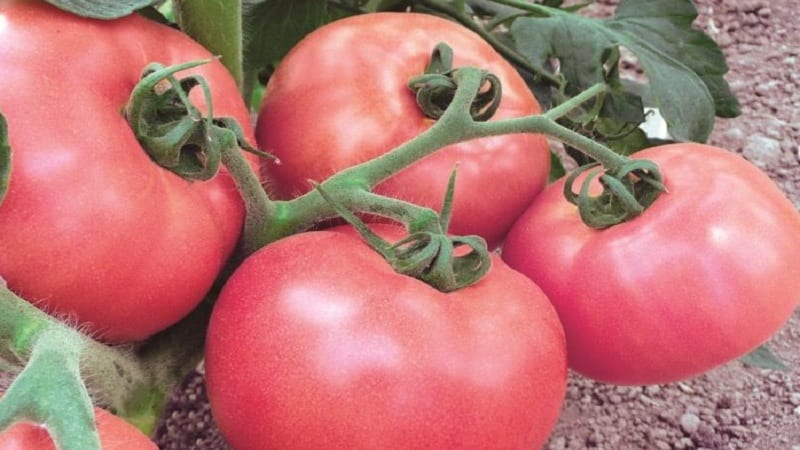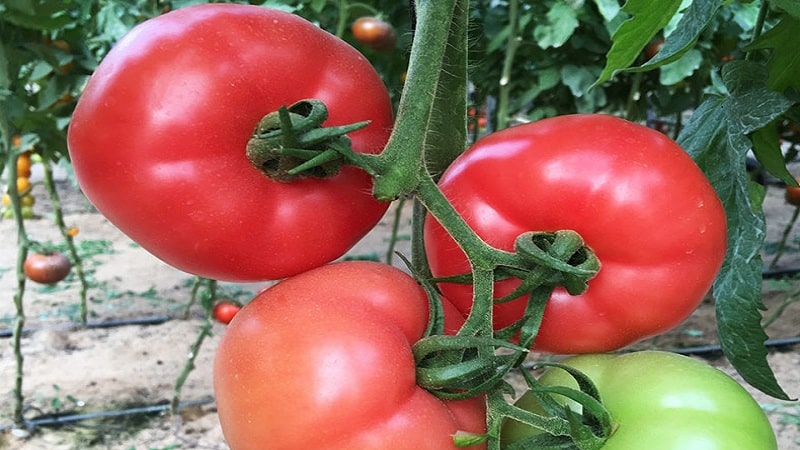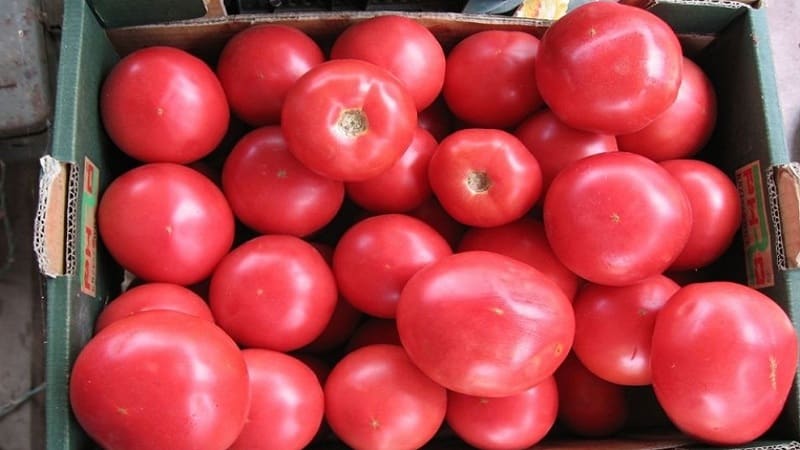How to grow a fragrant and tasty Pink Unicum tomato: a guide to action for beginners and experienced gardeners
Tomato Pink Unicum is a hybrid of Dutch selection that has absorbed the best qualities of its predecessors. The crop is easy to grow indoors and outdoors and obtain excellent results. The taste and aroma of the fruits are significantly superior to similar hybrids.
In this material we will talk about the pros and cons of tomatoes, agrotechnical techniques that allow you to get a high yield.
Characteristics and description of the hybrid
The mid-season tomato Pink Unicum f1 was bred by biologists from the Dutch company Monsanto, the world leader in plant biotechnology. It was added to the State Register of Russia in 2008. Initially, the crop was intended to be grown in greenhouses for sale, but over time, amateur gardeners became interested in tomatoes. Now the hybrid is cultivated both indoors and outdoors.
The plant is indeterminate, reaches 2–2.5 m in height. Characterized by strong immunity and resistance to adverse weather. Ovaries are formed even under stressful conditions.
In the photo - tomato Pink Unicum f1.

The table summarizes the distinctive features of the hybrid.
| Indicators | Characteristic |
| Weight | 250–300 g |
| Form | Round, slightly ribbed |
| Coloring | Pink, no green spot |
| Leaves | Medium size, dark green color |
| Type of inflorescences | Simple |
| Number of slots | Six or more |
| Pulp | Dense, meaty and juicy |
| Taste | Sweet, no sourness |
| Skin | Thin but doesn't crack |
| Purpose | Universal |
| Bush height | 2–2.5 m |
| Ripening period | 115–120 days |
| Productivity | 16–18 kg/m² |
| Sustainability | To the root-knot nematode, fusarium, cladosporiosis, verticillium, tobacco mosaic virus |
| Transportability | High |
Growing seedlings
As a rule, there are no problems with growing hybrid tomato seedlings. The germination rate of the seed is close to 100%. Sprouts appear simultaneously, seedlings develop strong and healthy.
Preparing the soil and sowing seeds
At home, seeds are not soaked in disinfecting solutions and growth stimulants, since they are treated with special compounds in production.
Sowing work begins in the second decade of March, 2 months before transferring the seedlings to a permanent place. For this you need light and nutritious soil. Gardening stores sell ready-made substrate in bags marked “universal.” It is suitable for growing tomato seedlings. You can also prepare the soil yourself from turf, humus and peat mixed in equal parts.
The soil is disinfected in an oven at a temperature of 110 ° C, steamed in a double boiler or poured with a hot concentrated solution of potassium permanganate.
Advice. Use the drug “Fitosporin-M” to disinfect the soil. The product helps protect seedlings from most nightshade diseases.
Boxes for seedlings are filled with a moist substrate and the seeds are laid out to a depth of 2 cm, leaving 2-3 cm between them. Cling film is stretched on top to create a greenhouse effect.
The containers are placed in a warm place, inaccessible to direct sunlight. Shoots will appear in 4–6 days at an air temperature of 23 °C. The film is lifted daily to ventilate the soil and prevent mold.
Seedling care
After germination, the film cover is removed and the boxes are taken out into sunlight. The ideal place is a window sill on the south side.
The first week the sprouts are not watered. As soon as 2-3 true leaves appear, the seedlings are planted in individual pots.
Water the seedlings moderately as the top layer of soil dries.
14 days after picking, ready-made complex formulations (Effecton, Agricola) or home remedies are applied as fertilizers.
Recipe for foliar and root feeding of tomato seedlings:
- superphosphate – 20 g;
- potassium sulfate – 10 g;
- urea – 5 g.
Seedlings are fed once every 14 days.
Pots for seedlings must be spacious to accommodate a powerful root system. Otherwise, after transfer to a permanent place, the roots will begin to actively develop. This will lead to inhibition of bush growth, yellowing of the lower leaves and absence of ovaries.
It is important to observe the daylight hours when growing seedlings. Optimally – 16 hours. If there is not enough sunlight, install phytolamps, otherwise the seedlings will stretch upward.
Comfortable air temperature is 22–24 °C.
Tomato cultivation
The agricultural technology of the Dutch hybrid is standard and includes pinching, shaping bushes and tying up stems, installing drip irrigation, loosening and weeding or mulching, and applying organic and mineral fertilizers.
Landing
Transferring seedlings to the ground begins in mid-May. In heated greenhouses it is permissible to sow and plant earlier. It is important to do this before the flower brush appears. But if it doesn’t work, the brush is removed, giving the plant the opportunity to begin active growth.
Greenhouses are prepared in the fall, treated with sulfur bombs to prevent bacteria and pests.The soil is dug up and fertilized with humus - 1 bucket per 1 m².
In spring, the soil is loosened and fertilized with humus - 10 liters per 1 m².
Add 1 tbsp to seedling holes 20 cm deep. l. superphosphate, pour in warm water and transfer the seedlings along with a lump of earth.
soil mulch peat, hay, sawdust, straw or covered with black agrofibre. This helps retain moisture in the soil, prevents the formation of a dense crust on its surface, the growth of weeds and the spread of bacteria and fungi.
Care
Hybrid Pink Unicum is formed into 1-2 stems, removing side shoots. The stems are tied to trellises or wooden stakes. After the fruits appear, pluck off all the leaves up to the first flower cluster, and then the rest as soon as the flowers begin to set. The foliage is left only at the top.
In the regions of the middle zone, in early August, the top is pinched and underdeveloped brushes are removed. In the south, a similar procedure is carried out in late August. All energy will be used to form the remaining fruits.
At watering tomatoes adhere to the principle: it is better to under-water than over-water. Plants like moderately moist soil, so drip irrigation is the best solution.
You can save on equipment using a homemade system made from plastic bottles. You will need to take containers of 2 and 5 liters. 2 liter bottles are cut into two parts. Settled water is poured into the lower part of the container, placed in a small depression in the ground and added a little bit for stability. The bottom of large five-liter bottles is cut off (about 5 cm) and placed on top of smaller containers of water.
How it works? The water gradually evaporates, and condensation accumulates inside a large container and flows down the walls into the ground.The root system receives a sufficient amount of moisture.

Important! After planting, the seedlings are left to take root in a new place. Watering is postponed for a week; fertilization begins after 14 days.
Organic and mineral fertilizers are used for fertilizing.
2 weeks after planting, tomato bushes are fertilized with nitrogen:
- mullein infusion – 1 l;
- infusion of green fertilizers – 1 l;
- wood ash – 1 l;
- water – 10 l.
The mixture is infused for 48 hours and used for watering at the root, 1 liter per bush.
To prepare liquid green fertilizer, fill the barrel ¾ full with green mass (cut grass, tops, weeds, shoots) and fill it to the top with water. Cover the container with a lid with holes and infuse the mixture for 7–10 days. The finished fertilizer becomes cloudy yellow-green in color and acquires the smell of fermented grass.
When flowers appear, the bushes are irrigated with boric acid to speed up the formation of ovaries and improve the taste of the fruit. Ratio: 5 g of substance per 5 liters of water. Treatment frequency: 1 time every 2 weeks.
After the ovaries appear, they proceed to treatment with a vitamin composition:
- water – 5 l;
- baking soda – 1 tbsp. l.;
- potassium permanganate - on the tip of the knife;
- iodine – 5 drops.
The bushes are sprayed with the prepared solution once every 7 days. Instead of water, you can use whey to protect plants from fungal diseases.
The hybrid needs potassium-phosphorus feeding. Gardeners prefer ready-made mineral compositions: “Kemira Lux”, “Calcium nitrate”, “Solution”, ammophos, nitrophoska, nitroammophos.
Features of growing in closed and open ground
A prerequisite for cultivating tomatoes indoors is control of temperature and air humidity.The room temperature should not be lower than 16 °C. The optimal moisture level is 70–80%.
In the southern regions, it is permissible to grow a hybrid in open ground if there are no sharp changes in the average daily temperature. The culture reacts painfully to stressful conditions: growth stops and the number of ovaries decreases.
But the plant is resistant to drought if you provide it with abundant watering.
Diseases and pests
Hybrid Pink Unicum is endowed with strong immunity at the genetic level.
The culture is not afraid of nightshade diseases:
- cladospirosis (brown spot);
- fusarium;
- verticillium;
- tobacco mosaic virus.
To be on the safe side, preventive treatments against late blight are used with “Fitosporin” and solutions with whey or kefir (100 ml of fermented milk product per 1 liter of water).
In the fall, greenhouses are disinfected with sulfur bombs, and in the spring the soil is treated with a 0.5% solution of copper sulfate (50 g per 10 liters of water, 2 liters per 1 m²).
Proper care helps prevent late blight infection: mulching and frequent weeding of the soil, removing weeds, monitoring moisture levels, removing lower leaves.
To combat aphids, spider mites, whiteflies, and mole crickets, use:
- insecticides: “Aktara”, “Vertimek”, “Decis Profi”, “Mospilan”, “Sirocco”, “Borey”;
- biological products: “Fitoverm”, “Nemabakt”, “Bitoxibacillin”, “Fitosporin-M”.
Harvesting and application
Harvesting begins approximately 110–115 days after germination. Tomatoes are harvested at the stage of full or milky ripeness. Green fruits are stored until December without losing their presentation and ripen together. But the taste quality deteriorates significantly - the characteristic tomato smell and taste are missing.
Fully ripened fruits have a pleasant, sweet taste that is superior to similar hybrids. Suitable for fresh consumption and canning for the winter.

Advantages and disadvantages
Advantages of Pink Unicum tomato:
- excellent taste and aroma of fruits;
- possibility of ripening outside the bushes;
- versatility of use in cooking;
- long shelf life;
- strong immunity;
- ease of care.
Flaws:
- the need for pinching and forming bushes with staking of heavy stems;
- deterioration of taste during ripening.
Farmer reviews
Hybrid Pink Unicum has gained well-deserved popularity among large farmers and amateur gardeners due to its ease of care, resistance to most diseases and excellent taste.
Veronica, Dubna, Tula region: “I grow Dutch hybrids in a greenhouse for sale. Tomato Pink Unicum is on the list of my favorites. This is a unique crop that is easy to care for. Resistance to various tomato diseases allows it to survive even with massive infection with cladosporiosis or late blight (as I had last year). The tomatoes are almost the same size, with excellent taste.”
Igor, Slavyansk-on-Kuban, Krasnoyarsk Territory: “I grow Pink Unicum in a greenhouse, although our climate conditions allow it to be done in open ground. In my deep conviction, tall tomatoes should be grown only in this way if you want to get a rich harvest and reduce labor costs for care. The culture is more than unpretentious in care, it rarely gets sick. The tomatoes are large, sweet, and can be picked green. In this form they are stored until winter, although the taste is lost.”
Conclusion
“Dutch” Pink Unicum has a number of unique characteristics that allow it to remain at the peak of popularity: strong immunity to viruses, bacteria and fungi, high yield with minimal labor costs, excellent taste of tomatoes, long shelf life and high level of transportation.
The culture feels great in protected and unprotected soil, subject to the rules of agricultural technology: moderate watering, fertilizing with minerals and organic matter, pinching and shaping the bush into 1-2 stems.